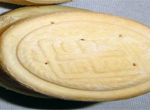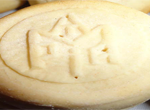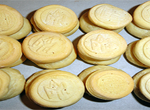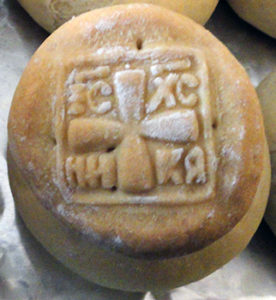




The word prosphora donates the bread which is brought to the Church as an offering for use in the preparation of the Holy Gifts for Holy Communion. Only the center part of the loaf is used for this purpose; the rest is distributed at the end of the Holy Liturgy to communicants and all worshipers in remembrance of the custom of the original Church the custom of Agape, or Christian love.
The symbolic importance of bread in the life of the Church and its worship is great. In this regard we hear the words of our Lord saying: I am the bread of life… I am the living bread which came down from heaven. If any man eat of this bread, he shall live forever, and the bread that I will give is my flesh, which I give for the life of the world. (John 6:51)
The role of the prosphora in the celebration of the Holy Liturgy of the Orthodox Church is therefore paramount. Indeed, the Holy Liturgy is a re-enactment and re-living of the Last Supper of our Lord. In connection with this we read:
The Lord Jesus, on the same night in which he was betrayed, took bread. And when he had given thanks, he broke it and said, “Take, eat; this is my body which is broken for you.
The round loaf of bread used in the preparation of the gifts of Holy Communion is called Prosphora, meaning “offering,” that is, the “bread of offering.” On the top surface of the prosphoron a seal is stamped that looks like this:
This center portion is called the “lamb,” since it is prepared at this part of the Liturgy (Proskomidia) and will become the body of the crucified Christ. It is removed by the priest and placed on the patent The Greek letters IC and XC are abbreviations for the words Jesus Christ. The combination of the letters NI and KA means “conquers,” from the Greek nikao, “to conquer.”
The large triangular piece is then removed and placed on the paten in honor and commemoration of our Lord’s Mother, the Blessed Virgin Mary. Then the nine smaller triangular pieces are removed and also placed on the patent These commemorate the Old Testament Patriarchs, the Angelic Hosts, and the Prophets, Apostles and Saints of the Holy Orthodox Church.
In the early days the word prosphora (from the Greek, meaning “offering”) was used to designate the food offered by Christians, the best portion of ‘,which was used for the Eucharist, and the remainder for the love-feast (agape) after Liturgy. When Liturgy was separated from the love-feast the word came to designate only the bread used during the celebration of Liturgy. This bread was usually round and flat and bore the imprint of a cross. Later the inscription IC XC NI KA (“Jesus Christ Conquers”) accompanied the cross; it recalls the inscription on St. Constantine the Grate’s banner, but is earlier in origin. The prosphora used by the Egyptians and Syrians had several large crosses in the middle surrounded by many smaller crosses. Bread with the seal of the offered was also used.
From the 6th century several Churches decreed that the outward appearance of the prosphora used for Liturgy be identical in all the parishes of the given Church.
Today the Russian Orthodox Church uses prosphora which consist of two round parts, “signifying that Jesus Christ. having two natures, divine and human, in His hypostatic union, offers Himself as a heavenly and earthly’ sacrifice to His Eternal Father through this prosphora in the Sacrament of the Eucharist. On the prosphora, which represents the Sacrifice on the Cross offered on the Heavenly Altar, the Church has decreed that a cross should be imprinted with the Name of Jesus Christ and the word NIKA, signifying the victory of Christ (I. Dmitrevsky, Istoricheskoe, dogmaticheskoe i tainstvennoe izyasnenie Bozhestvennoi liturgies-An Historical, Dogmatic and Sacramental Explanation of the Divine Liturgy. St. Petersburg, 1884, p. 104). The use of this seal on the prosphora of the Russian Church was affirmed by the Great Moscow Council in 1667.
The seal on the prosphora is round or square. The square seal and the part, called the Lamb, symbolizes the divinity and humanity of Christ, the Son of God.
“If this seal on the bread were round, they would signify only (eternity, that is, that the Godhead has no beginning and no end. But since the Son of God, also without beginning or end, was made incarnate and revealed that He was God, Who came to earth for our sake, was made incarnate, truly suffered and was in the likeness of God and the likeness of man, the seal and the bread itself should .symbolize both divinity and humanity. Jesus Christ is perfect in each nature.’ His (1ivinitv was perfectly united with His humanity. For this reason the bread should also be square. not round and unleavened. For ‘since Jesus Christ is perfect, He became a perfect Man, and took a human soul an (l body consisting of the four elements. And just as the world has four corners, so. too, the Word Himself, Christ, the Creator of the World, took on human flesh consisting of the four elements, and just As He blessed the four corners of the world, all things heavenly and earthly, as the Incarnate Word, so, too, is this represented by His Cross, whereon He was crucified. and died, and made atonement for us and the whole world”
(Veniamin, Archbishop of Nizhni Novgorod and Arzamas, Novaya Skrizhal-(The New Tablet. p.166).
For the churches of the Old Rituality, an eight-pointed cross is permitted.
In certain churches and particularly in monasteries, as an exception the seal can depict a feast, an icon or a Saint especially revered in the locality. Prosphora with such seals are usually intended for distribution to believers and is not used for Divine Liturgy. Local practice does. however, permit a particle in honor of the Mother of God to be removed from a prosphora with Her image during the Proskomidia.
Russian style of prosphora
If using a five pound bag of flour — pour approximately 1/4 of the bag into bowl add pinch of salt or similar amount pour boiling hot water into this flour and mix to pasty consistency ( until all the flour from this 1/4 amount is mixed).
Set the mixture aside and let cool for approximately 45 -50 minutes. Once cool add yeast ( one packet of yeast per 5 pounds although when I use 20 pounds 2 packets are enough) and 2-4 cups of warm water , and rest of flour.
Knead dough until it becomes bouncy or rubbery when compressed – a bit like play dough consistency.
Let rise for 1 hour when ready knead dough again for about 5 minute then proceed with prosphora shapes as usual bake at 350 covered for 20 -35 minutes
Remove from sheet cover and let cool. NOTE : I bake the prosphora on professional bakers cookie sheets .
Once prosphora cool after a few hours, place in freezer bags and freeze until needed. Take prosphora out the night before liturgy and just leave the bag open . By morning they are just as fresh as baked.
